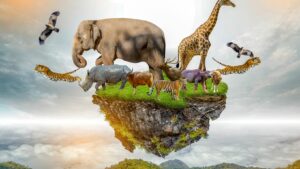Wildlife photography jobs offer a unique blend of adventure, artistry, and conservation, capturing the imagination of many aspiring photographers. This niche requires not only a keen eye for detail and a passion for the natural world but also a deep understanding of animal behavior and ecosystems. It’s a field where patience meets opportunity, and the rewards—though sometimes challenging to attain—are incredibly fulfilling.
Wildlife Photography Jobs
 Wildlife photography jobs offer a rare combination of adventure, artistic expression, and advocacy for conservation. Individuals in these roles need a deep understanding of wildlife behavior and ecosystems, coupled with patience and a passion for nature. These photographers play an essential role in storytelling, focusing on conservation efforts and educating the public about the importance of preserving natural habitats. Moreover, the challenges faced in wildlife photography, such as the unpredictability of animal behavior and varying natural conditions, demand resilience and adaptability. However, the fulfillment derived from capturing the beauty and fragility of the natural world makes these jobs highly rewarding for those committed to making a difference through their art.
Wildlife photography jobs offer a rare combination of adventure, artistic expression, and advocacy for conservation. Individuals in these roles need a deep understanding of wildlife behavior and ecosystems, coupled with patience and a passion for nature. These photographers play an essential role in storytelling, focusing on conservation efforts and educating the public about the importance of preserving natural habitats. Moreover, the challenges faced in wildlife photography, such as the unpredictability of animal behavior and varying natural conditions, demand resilience and adaptability. However, the fulfillment derived from capturing the beauty and fragility of the natural world makes these jobs highly rewarding for those committed to making a difference through their art.
Skills Required for Wildlife Photography Jobs
Technical Proficiency
Photographers must master their camera equipment, understanding settings that work best in varying natural lights and movements. They need knowledge of lenses appropriate for distant or close-up wildlife shots, and editing software skills for post-processing.
Patience and Persistence
Wildlife photography demands patience to capture the perfect moment and persistence despite unpredictable challenges. Success often comes from hours or days of waiting for the right shot.
Knowledge of Animal Behavior
Understanding animal behavior is crucial for anticipating actions and ensuring safety. This knowledge helps photographers position themselves optimally without disturbing the wildlife.
Physical Fitness and Endurance
The job requires fitness and endurance to navigate difficult terrains, sometimes under harsh weather conditions. Photographers must carry heavy equipment over long distances, often on foot.
Conservation Awareness
A deep appreciation for conservation efforts and ethical photography practices is essential. Photographers should aim to raise awareness without harming animals or their habitats.
Finding Wildlife Photography Jobs
 Securing wildlife photography jobs combines one’s passion for nature and art with the determination to find opportunities that showcase the beauty and complexity of the natural world. Wildlife photographers often begin their journey by building a robust portfolio that highlights their understanding of wildlife, technical skills, and unique perspective on nature. Networking plays a crucial role, as connecting with professionals in the field, attending workshops, and joining wildlife conservation groups can open doors to potential job offers. Additionally, leveraging social media platforms and photography websites to display one’s work increases visibility to potential employers and clients. Freelancing for magazines, newspapers, and online publications serves as another viable path, alongside collaborating with conservation organizations or wildlife reserves that value the role of photography in promoting their conservation efforts. Every wildlife photographer’s path may vary, but dedication, skill, and the relentless pursuit of opportunities are key to turning one’s passion into a career in wildlife photography.
Securing wildlife photography jobs combines one’s passion for nature and art with the determination to find opportunities that showcase the beauty and complexity of the natural world. Wildlife photographers often begin their journey by building a robust portfolio that highlights their understanding of wildlife, technical skills, and unique perspective on nature. Networking plays a crucial role, as connecting with professionals in the field, attending workshops, and joining wildlife conservation groups can open doors to potential job offers. Additionally, leveraging social media platforms and photography websites to display one’s work increases visibility to potential employers and clients. Freelancing for magazines, newspapers, and online publications serves as another viable path, alongside collaborating with conservation organizations or wildlife reserves that value the role of photography in promoting their conservation efforts. Every wildlife photographer’s path may vary, but dedication, skill, and the relentless pursuit of opportunities are key to turning one’s passion into a career in wildlife photography.
Opportunities and Challenges
In the realm of wildlife photography jobs, photographers encounter a multifaceted landscape brimming with both opportunities and challenges. They excel as vital storytellers, using their lenses to capture the untold stories of nature, thereby playing a pivotal role in conservation efforts. The opportunity to influence public perception and foster a deeper appreciation for the natural world stands as a compelling motivator for many in this field.
Finding wildlife photography jobs necessitates not only a comprehensive understanding of animal behavior and ecosystem dynamics but also demands high levels of physical stamina to endure the often punishing conditions of natural habitats.
Monetizing Your Wildlife Photography
Embarking on a career in wildlife photography is more than capturing breathtaking shots; it’s about telling the untold stories of nature and contributing to conservation efforts. The journey demands a blend of technical prowess, deep understanding of the natural world, and an unwavering commitment to the craft. Success in this field isn’t just about having the right gear but also about building a portfolio that resonates with audiences and showcases a unique perspective on wildlife. Networking and aligning with organizations dedicated to conservation can open doors to opportunities that align with your passion for nature and photography.


